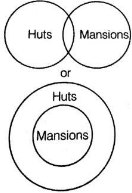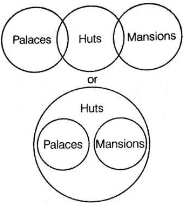Practice Mock Test for SNAP - 4 - CAT MCQ
30 Questions MCQ Test - Practice Mock Test for SNAP - 4
Read the sentence (given below as options) to find out whether there is any grammatical error in it. The sentences are In three separate parts and each one is labelled (a), (b), (c) and (d). In that case, letter (d) will signify a ‘No error’ response.
Find out the error part of the following sentences.
Read sentence to find out whether there is any grammatical error in it. The sentences are In three separate parts and each one is labelled (a), (b), (c) and (d). In that case, letter (d) will signify a ‘No error’ response.
Directions: Choose the correct alternative which can be substituted for the below given word/ sentence.
To hold one's tongue
Directions: Choose the appropriate meaning of the idiom:
Make up one's mind
Directions: In the sentence given below, replace the phrase underlined to make the sentence grammatically correct. If the sentence is correct as it is, mark (d) i.e. “No correction required” as the answer.
Q. Whether I stay in Mumbai or Pune, it is all and one to me.
Directions: In the following question, an idiom or proverb has been underlined. Choose its correct meaning in the given context from the alternatives given below.
Her fame spread far and wide because she was a talented singer.
Q. Her fame spread far and wide because she was a talented singer.
Directions: Choose the correct alternative which can be substituted for the below given word/ sentence.
Q. A person who talks in sleep is called as
Directions: Choose the correct alternative which can be substituted for the given word/ sentence.
Q. A person involving in an activity for pleasure and not money is called as ___
Directions: Choose the correct alternative which can be substituted for the below given word/ sentence.
Q. A person who eats too much is called as _______
Author is related to Book as Choreographer is related to _____?
Glutton is related to Eat as Garrulous is related to _____?
Directions: The given sentence is in active/ passive voice. Change the voice of the sentence. Select the correct option from the sentence below.
Q. He has a gut feeling that his brother may be keeping a secret.
Three of the following four are alike in a certain way and so form a group. Which is the one that does not belong to that group?
Directions: In these questions, assuming the given statements to be true. Find which of the conclusions numbered I and II is/are definitely true and give your answer accordingly.
Statements: J < K ≥ O = Z , K ≤ Q< S
Conclusions:
I. Q > Z
II. S ≤ Z
How many such pairs of letters are there in the word JUMPING, each of which has as many letters between them in the word (in both forward and backward directions) as in the English alphabetical series?
Directions: Study the arrangement carefully and answer the questions given below.
4 2 6 1 3 8 9 5 8 1 6 5 1 5 8 5 3 9 4 9 2 3 2 1 5 7 2 6 2 4 2 7 4
Q. If one is added to each of the digits and two is added to each of the odd digits given in the above arrangement, then how many digits will appear exactly twice in the new number thus formed?
Directions: Seven friends namely A, B, C, D, E, F and G are standing in a straight line facing North but not necessarily in the same order. D stands exactly in the centre of the line. Only two persons stand between D and F.
A stands to the immediate left of C.
A stands to the right of D (may or may not be the immediate right). Only one person stands between A and B. G stands second to the left of B.
Q. Which of the following represents the position of B from the left end of the line?
Directions: Six people – C, D, E, F, G and H are standing in a straight line facing North not necessarily in the same order. D is standing second to the right of F. C is standing fourth to the left of H and H is not standing on the extreme end of the line. E is standing second to the right of D.
Q. Which of the following pairs represents the people standing at the extreme ends of the line?
Directions: In the given information and answer the questions.
When a word and number arrangement machine is given an input line of words and numbers it arranged them following a particular rule. The following is an illustration of input and rearrangement. (All the numbers are two-digit numbers)
Input left 46burn 82 95 part 72 vibe bold 49 mint 59
Step I 95 left 46 burn 82 part 72 vibe 49 mint 59 bold
Step II 82 95 left 46 part 72 vibe 49 mint 59 bold burn
Step III 72 82 95 46 part vibe 49 mint 59 bold burn left
Step IV 59 72 82 95 46 part vibe 49 bold burn left mint
Step V 49 59 72 82 95 46 vibe bold burn left mint part
Step VI 46 49 59 72 82 95 bold burn left mint part vibe
Step VI is the last step of the above arrangement as the intended output of arrangement is obtained. As per the rules followed in the given steps, find the appropriate steps for the given input.
Input 29 cone 42 pale fear 39 67 fame 32 weld 77 turn
Q. Which step number is the following output?77 29 42 pale fear 39 67 fame 32 weld turn cone
Directions: In the given information and answer the questions.
When a word and number arrangement machine is given an input line of words and numbers it arranged them following a particular rule. The following is an illustration of input and rearrangement. (All the numbers are two-digit numbers)
Input left 46burn 82 95 part 72 vibe bold 49 mint 59
Step I95 left 46 burn 82 part 72 vibe 49 mint 59 bold
Step II 82 95 left 46 part 72 vibe 49 mint 59 bold burn
Step III 72 82 95 46 part vibe 49 mint 59 bold burn left
Step IV 59 72 82 95 46 part vibe 49 bold burn left mint
Step V49 59 72 82 95 46 vibe bold burn left mint part
Step VI 46 49 59 72 82 95 bold burn left mint part vibe
Step VI is the last step of the above arrangement as the intended output of arrangement is obtained. As per the rules followed in the given steps, find the appropriate steps for the given input.
Input 29 cone 42 pale fear 39 67 fame 32 weld 77 turn
Q. Which of the following is the fifth element to the right of ‘29’ in step II?
Directions: The question consists of a question and two statements numbered I and II given below it. You have to decide whether the data given in the statements are sufficient to answer the questions. Read both the statements and choose the most appropriate option.
Q. Among six people A, B, C, D, E and F each having a different height who is the second tallest?
I. Only two people are shorted than D. Only two people are taller than A. E is shorter than C. D is taller than F.
II. Only three people are shorter than A. B is shorter than D but not the shortest. C is the tallest amongst them.
Directions: Read the given information carefully and answer the questions.
Each of the six buildings P, Q, R, S, T and U houses different number of offices. S has more offices than only T and R. Q has more number of offices than P but less than U. R does not house the least number of offices. The building which houses the least number of offices has 5 offices. The building which has second highest number of offices has 23 offices. S has 11 fewer offices than Q.
Q. Which of the following is the number of offices in building R?
Directions: The questions below are two statements followed by two conclusions numbered I and II. You have to take the three given statements to be true even if they seem to be at variance from commonly known facts and then decide which of the given conclusions logically follows from the three given statements disregarding commonly known facts. Then decide which of the answer (a), (b), (c), (d) and (e) is the correct answer.
Statements:-
I. Some huts are mansions.
II. No mansion is a palace.
Conclusions:-
I. All palaces being huts is a possibility.
II. All huts are palaces.
Directions: In each question below a statement is given followed by two courses of action numbered I and II. A course of action is a practicable and feasible step or administrative decision to be taken for follow-up, improvement, or further action in regard to the problem, policy, etc. On the basis of the information given in the statement, you have to assume everything in the statement to be true and decide which of the suggested courses of action logically follow(s) for pursuing.
Statement: Number of hospital beds per 1000 people in India, which is a key indicator of healthcare infrastructure, is much lower than many other nations which are thought to be poorer than India.
Courses of Action
I. The expenditure of importing costly medicines should be borne by the state.
II. Incentives should be given to encourage entry of private players into building of healthcare infrastructure.
Directions: In each question below a statement is given followed by two assumptions numbered I and II. An assumption is something supposed or taken for granted. You have to consider the statement and the following assumptions and decide which of the assumptions is implicit in the statement.
Statement: An advertisement by bank X-'Our interest rates for education loan are lower than any other bank'.
Assumptions
I. Some other banks also provide education loan.
II. Interest rates charged on education loan are different for different bank..
Directions: In each question below a statement is given followed by two assumptions numbered I and II. An assumption is something supposed or taken for granted. You have to consider the statement and the following assumptions and decide which of the assumptions is implicit in the statement.
Statement: Farmers must immediately switch over to organic fertilizers from chemical fertilizers for better yield.
Assumptions
I. All the farmers use only chemical fertilizers.
II. Organic fertilizers are readily available to the farmers.
Directions: The questions below are two statements followed by two conclusions numbered I and II. You have to take the three given statements to be true even if they seem to be at variance from commonly known facts and then decide which of the given conclusions logically follows from the three given statements disregarding commonly known facts. Then decide which of the answer (a), (b), (c), or (d) is the correct answer.
Statements: All leaves are flowers. No flower is a branch. Some branches are trees.
Conclusions
I. Some trees are leaves.
II. No tree is a flower.























